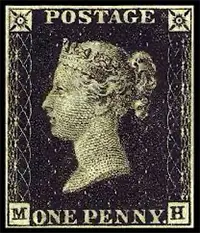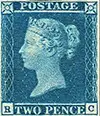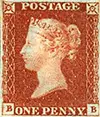Penny Black: the First Postage Stamp
The Penny Black, issued by the United Kingdom in 1840, was the world's first postage stamp. In the U.K. in the early 19th Century, people sent letters and sometimes packages through the mail, as it existed in those days, but the payment for such transport varied, usually from expensive to very expensive. As well, it was common practice for the receiver of a letter or package to pay for the postage required, which would be more if the distance traveled from sender to receiver was more than a short walk across town. 
Sir Rowland Hill, an English teacher and social reformer, had proposed a postal service that most people could afford. The British Treasury agreed and on Aug. 22, 1839, announced a competition for designs. The winner was to receive £200, which was quite a bit of money in those days, and the runner-up was to receive £100. The government received a total of 2,700 entries. In the end, none of those was the winning design. Instead, the Penny Black, as it was called, was the product of one Henry Corbould. The first date of sale was May 1, 1840. The stamp was valid from May 6 of that year. The background of the stamp was black, and the main image was a bust of Queen Victoria, the U.K. monarch at the time, in profile. Each of these stamps cost one penny, and one stamp would cover the cost of sending a letter or package that weighed no more than half an ounce, no matter how far the distance between sender and receiver. The word "POSTAGE" was included at the top of the stamp to make clear that this was not a revenue stamp, of the kind that so agitated American printers in the mid-18th Century. 

Soon following the Penny Black was the Twopenny Blue, which closely resembled the Penny Black but cost twice as much. A third stamp, the Penny Red, proved more durable than the Penny Black because the red cancellation mark on a black background proved too difficult to see and too easy to remove, making it all the easier for someone to reuse a stamp. Other countries began issuing their own stamps, notably the United States in 1847. |
|
Social Studies for Kids
copyright 2002–2024
David White




